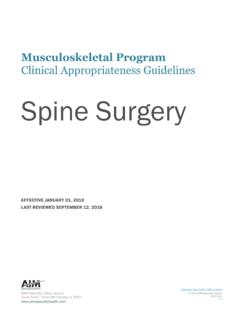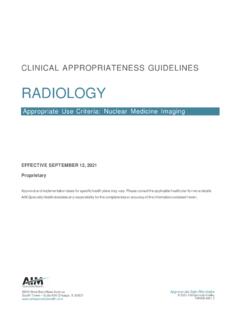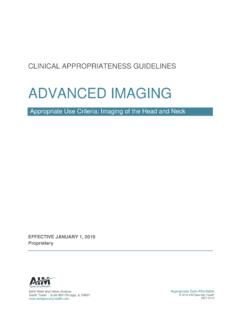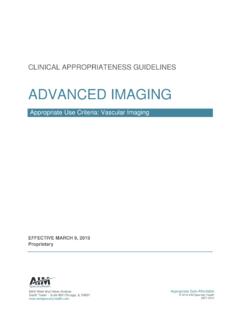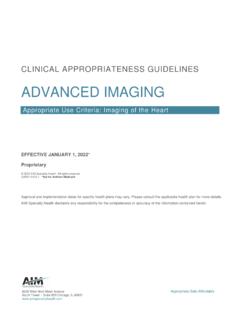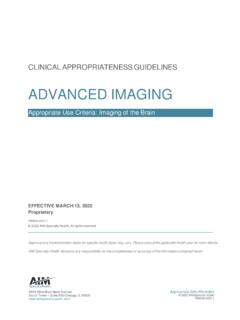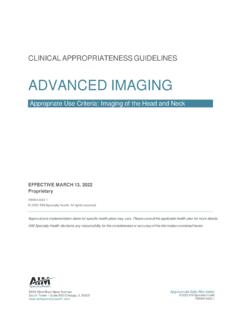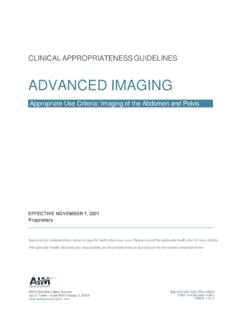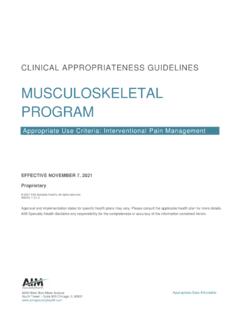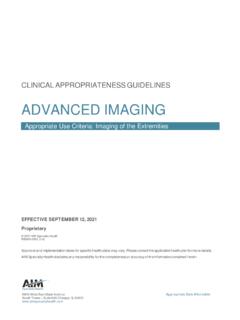Transcription of Clinical Appropriateness Guidelines: Advanced Imaging
1 Clinical Appropriateness Guidelines: Advanced Imaging Appropriate Use Criteria: Imaging of the Spine Effective Date: September 5, 2017. Proprietary Date of Origin: 03/30/2005. Last revised: 07/26/2016. Last reviewed: 07/26/2016. 8600 W Bryn Mawr Avenue South Tower - Suite 800. Chicago, IL 60631. P. Copyright 2017. AIM Specialty Health. All Rights Reserved Table of Contents Description and Application of the Guidelines Description and Application of the Administrative Guidelines Ordering of Multiple Pre-test Spine Imaging CT of the Cervical MRI of the Cervical CT of the Thoracic MRI of the Thoracic CT of the Lumbar MRI of the Lumbar MRA of the spinal Spine Table of Contents | Copyright 2017.
2 AIM Specialty Health. All Rights Reserved. 2. Description and Application of the Guidelines AIM's Clinical Appropriateness Guidelines (hereinafter AIM's Clinical Appropriateness Guidelines or the Guidelines ) are designed to assist providers in making the most appropriate treatment decision for a specific Clinical condition for an individual. As used by AIM, the Guidelines establish objective and evidence-based, where possible, criteria for medical necessity determinations. In the process, multiple functions are accomplished: To establish criteria for when services are medically necessary To assist the practitioner as an educational tool To encourage standardization of medical practice patterns To curtail the performance of inappropriate and/or duplicate services To advocate for patient safety concerns To enhance the quality of healthcare To promote the most efficient and cost-effective use of services AIM's guideline development process complies with applicable accreditation standards.
3 Including the requirement that the Guidelines be developed with involvement from appropriate providers with current Clinical expertise relevant to the Guidelines under review and be based on the most up to date Clinical principles and best practices. Relevant citations are included in the References section attached to each Guideline. AIM reviews all of its Guidelines at least annually. AIM makes its Guidelines publicly available on its website twenty-four hours a day, seven days a week. Copies of AIM's Clinical Appropriateness Guidelines are also available upon oral or written request. Although the Guidelines are publicly-available, AIM considers the Guidelines to be important, proprietary information of AIM, which cannot be sold, assigned, leased, licensed, reproduced or distributed without the written consent of AIM.
4 AIM applies objective and evidence-based criteria and takes individual circumstances and the local delivery system into account when determining the medical Appropriateness of health care services. The AIM Guidelines are just guidelines for the provision of specialty health services. These criteria are designed to guide both providers and reviewers to the most appropriate services based on a patient's unique circumstances. In all cases, Clinical judgment consistent with the standards of good medical practice should be used when applying the Guidelines. Guideline determinations are made based on the information provided at the time of the request.
5 It is expected that medical necessity decisions may change as new information is provided or based on unique aspects of the patient's condition. The treating clinician has final authority and responsibility for treatment decisions regarding the care of the patient and for justifying and demonstrating the existence of medical necessity for the requested service. The Guidelines are not a substitute for the experience and judgment of a physician or other health care professionals. Any clinician seeking to apply or consult the Guidelines is expected to use independent medical judgment in the context of individual Clinical circumstances to determine any patient's care or treatment.
6 The Guidelines do not address coverage, benefit or other plan specific issues. If requested by a health plan, AIM. will review requests based on health plan medical policy/guidelines in lieu of AIM's Guidelines. The Guidelines may also be used by the health plan or by AIM for purposes of provider education, or to review the medical necessity of services by any provider who has been notified of the need for medical necessity review, due to billing practices or claims that are not consistent with other providers in terms of frequency or some other manner. CPT (Current Procedural Terminology) is a registered trademark of the American Medical Association (AMA).
7 CPT five digit codes, nomenclature and other data are copyright by the American Medical Association. All Rights Reserved. AMA does not directly or indirectly practice medicine or dispense medical services. AMA assumes no liability for the data contained herein or not contained herein. Guideline Description and Administrative Guidelines | Copyright 2017. AIM Specialty Health. All Rights Reserved. 3. Administrative Guideline: Ordering of Multiple Studies Requests for multiple Imaging studies to evaluate a suspected or identified condition and requests for repeated Imaging of the same anatomic area are subject to additional review to avoid unnecessary or inappropriate Imaging .
8 Simultaneous Ordering of Multiple Studies In many situations, ordering multiple Imaging studies at the same time is not clinically appropriate because: Current literature and/or standards of medical practice support that one of the requested Imaging studies is more appropriate in the Clinical situation presented; or One of the Imaging studies requested is more likely to improve patient outcomes based on current literature and/or standards of medical practice; or Appropriateness of additional Imaging is dependent on the results of the lead study. When multiple Imaging studies are ordered, the request will often require a peer-to-peer conversation to understand the individual circumstances that support the medically necessity of performing all Imaging studies simultaneously.
9 Examples of multiple Imaging studies that may require a peer-to-peer conversation include: CT brain and CT sinus for headache MRI brain and MRA brain for headache MRI cervical spine and MRI shoulder for pain indications MRI lumbar spine and MRI hip for pain indications MRI or CT of multiple spine levels for pain or radicular indications MRI foot and MRI ankle for pain indications Bilateral exams, particularly comparison studies There are certain Clinical scenarios where simultaneous ordering of multiple Imaging studies is consistent with current literature and/or standards of medical practice. These include: Oncologic Imaging Considerations include the type of malignancy and the point along the care continuum at which Imaging is requested Conditions which span multiple anatomic regions Examples include certain gastrointestinal indications or congenital spinal anomalies Repeated Imaging In general, repeated Imaging of the same anatomic area should be limited to evaluation following an intervention, or when there is a change in Clinical status such that Imaging is required to determine next steps in management.
10 At times, repeated Imaging done with different techniques or contrast regimens may be necessary to clarify a finding seen on the original study. Repeated Imaging of the same anatomic area (with same or similar technology) may be subject to additional review in the following scenarios: Repeated Imaging at the same facility due to motion artifact or other technical issues Repeated Imaging requested at a different facility due to provider preference or quality concerns Repeated Imaging of the same anatomic area (MRI or CT) based on persistent symptoms with no Clinical change, treatment, or intervention since the previous study Repeated Imaging of the same anatomical area by different providers for the same member over a short period of time Guideline Description and Administrative Guidelines | Copyright 2017.
